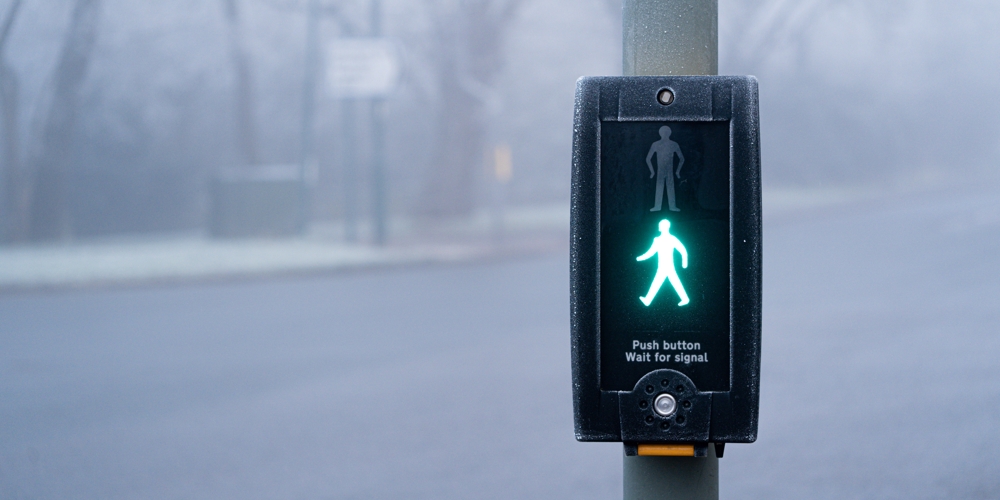
In this lesson, you will learn about pedestrian crossings and general pedestrian safety.
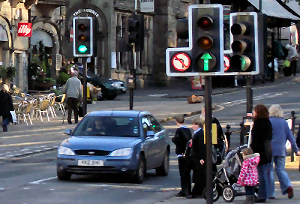 Most of us are pedestrians at some time almost every day - walking to the car, crossing the road to the shops, exercising the dog, etc.
Most of us are pedestrians at some time almost every day - walking to the car, crossing the road to the shops, exercising the dog, etc.
As pedestrians, we are very vulnerable if we come into contact with moving vehicles.
For this lesson, also consider people in wheelchairs and mobility scooters to be 'pedestrians'. Although this group of people are not walking, they have the same needs when using the road.
When driving, you need to be on the look for pedestrians in all situations to ensure that they stay safe - and that you keep a clean driving licence and a clear conscience.
There is no 'nice' way to say it, but it's dead easy to injure or kill pedestrians if you are not alert and aware. Pedestrians represent 23% of all road fatalities worldwide.
Pedestrian safety means being alert and taking action, especially where the most vulnerable groups of pedestrians are involved, the old and the young.
You can find the Highway Code rules for pedestrian crossings here.
Although this lesson is primarily about pedestrian crossings, be prepared to give way to pedestrians at all times.
For example, the Highway Code tells us to give way to pedestrians who are crossing the road when you are turning at junctions.
Sometimes pedestrians can do crazy things like running into the road or crossing the road without looking properly - but that doesn't mean that you can drive into them!
Whether you see kids on the footpath, older adults looking uncertain or hikers on a country road, drive defensively by easing off the gas and being prepared to stop.
For over 35 3D briefing videos visit Driving test Success. (Google Play | App Store - appstore practical videos available as an in app purchase in the 4 in 1 kit)
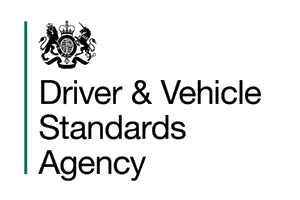
During your driving test, your examiner will mark how you deal with pedestrian crossings. The examiner will also consider your 'anticipation of the actions of pedestrians'. You must be alert for the actions of pedestrians at all times.
The examiner will want to see:
Correct action at crossings means approaching at a safe speed, giving way where necessary and complying with traffic light signals and instructions from school crossing wardens or other people guiding pedestrians across the road.
Examiners will also expect you to be alert and respond to warning signs about pedestrians, such as driving at a safe speed if you see a 'playground' sign.
All of the signs below indicate that there is a risk to pedestrians ahead - be prepared to slow down and stop if necessary.
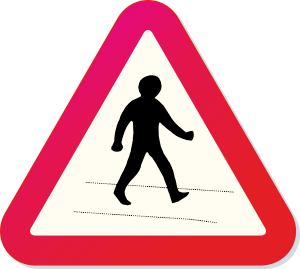
Pedestrian crossing
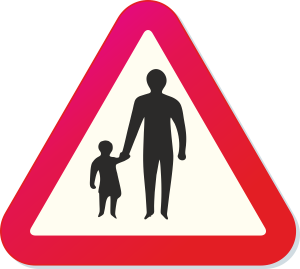
Pedestrians in the road
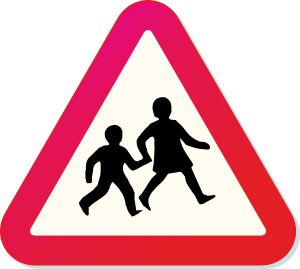
School or playground
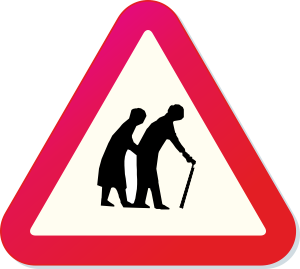
Elderly people crossing
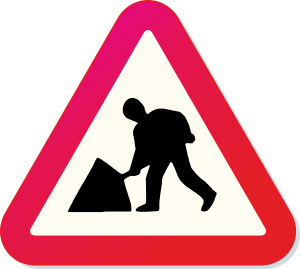
Road works - it might seem unusual to include road works
here - but there will often be workmen stepping into
the road who might not be giving the traffic their full
attention,

The dangers could be anywhere when dealing with pedestrians on the road.
Perhaps first, it's essential to consider those most at risk. In reality, all pedestrians are at risk on the road, but some are more aware of the risk and better able to react to it than others.
Those most at risk include:
The elderly
Young people and children
Those who are physically disabled
Those who have learning disabilities
Some of these groups are pretty easy to spot, for example, the old and the young, but could you easily spot someone who is deaf? Or somebody with a learning disability that prevents them from making safe decisions about crossing the road?
As a general rule, don't assume that pedestrians will:
See you
Hear you
And certainly don't expect them to do the right thing!
Most pedestrians will act sensibly, but you need to be able to deal with all the pedestrians, regardless of how they are behaving.
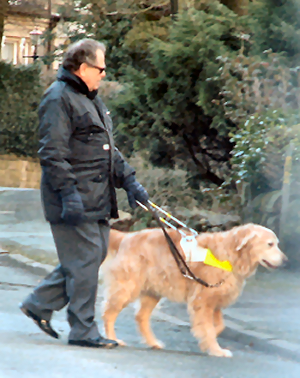
Some blind people are relatively easy to spot. They may have guide dogs, carry white sticks or have other people guiding them. But all visual impairments are so obviously apparent. For example, some people only have one eye and their field of vision is limited as a result - they might not see you.
Did you know that a blind person carrying a white stick with two red rings/bands around it is also deaf?
Take special care if you see blind people near a junction. The traffic noise can often be disorientating for those who can't see; they may step into the road unexpectedly.
Having been a child yourself, you will know that children do not always pay attention to the dangers around them. Although we're talking about pedestrian safety here, children are equally vulnerable on bicycles, scooters, mini motorbikes, go-karts, etc.
If you see a group of children, expect them to start running or chasing each other. If you see a child on their own, ask yourself, "Where is their friend or dog?"
A kid's bicycle or children's toys abandoned on the footpath will suggest that the children are not far away and perhaps likely to dash out from behind the next parked car.
The time of day is often relevant to child safety as well - be aware of the time that schools come out in your area; you can be sure that kids won't be thinking about homework or traffic.
As we grow older, we become slower and less agile. This, coupled with poor sight and hearing, means that we won't react to traffic as well as younger people. New traffic systems, lights and crossings can also confuse some older adults. All of these things mean that drivers need to take special care.
But remember, it's not just the old and young who are at risk as pedestrians. All pedestrians are vulnerable, so take care, be patient and always be prepared to give way.

We include several types of pedestrian crossings in this lesson, but there is only one method to approach them safely.
If you have been following the advice in DriverActive, you will already know the routine for approaching crossings and have almost certainly practised it in several other situations.
As with all dangers on the road, you will use your hazard routine on the approach to crossings.
There are several clues to look for that indicate a crossing or other 'heightened risk' area for pedestrians. Be alert for road signs, traffic lights and school signs and so on.
When you spot a crossing (or warning sign), your first job is to check your mirrors.
The mirror check is crucial at crossings because you need to decide whether to stop or not. It wouldn't be much help for pedestrians if you stopped, but the driver behind you didn't!
When you check your mirrors, you are asking yourself the questions:
Are there any people on or around the crossing? Is there anyone who looks as though they might be thinking of crossing?
You need to assess the situation early, so there are no sudden surprises as you get nearer the crossing. Your approach speed must be slow enough to stop safely if necessary.
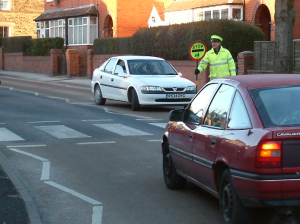
The next part of your routine is to consider a signal.
The most common signal at pedestrian crossings is the brake lights. You will automatically use these if you decide to stop, but you can also use them as a 'deliberate' warning to drivers behind.
In some situations, a light touch on the brake pedal, enough to activate the brake lights but make little or no difference to your speed, will be helpful to alert following drivers that you might stop at the crossing.
Although no longer widely used, a slowing down arm signal can sometimes be helpful, especially at Zebra Crossings. An arm signal not only warns drivers behind that you are slowing down, but drivers coming towards you can also see it - this can help them with their decision about stopping.
At crossings where there are two (or more) lanes of traffic, avoid changing lanes on approach - this can distract other drivers. Also, if you are concentrating on a safe lane change, you are not giving your full attention to the crossing.
It is illegal to overtake the 'leading vehicle' as you approach. The 'leading vehicle' is the vehicle closest to the crossing.
Where there are two or more lanes, you can pass vehicles in another lane (in traffic queues) but you MUST NOT pass the vehicle at the front of the queue (the one nearest to the crossing).
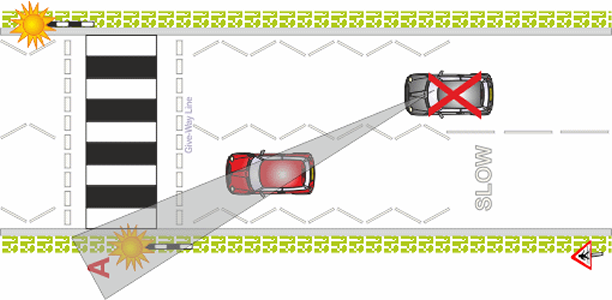
Looking at the diagram above, you will see that a pedestrian standing at point 'A' might not see the car marked with an X, and the driver of that car would not see the pedestrian. If the red car stops, disaster will follow when the pedestrian walks across.
Overtaking at any pedestrian crossing is dangerous and, in most cases, illegal.
Having seen the crossing, checked your mirrors, and adjusted your speed and position, you must decide whether to stop or carry on without stopping.
The decision about stopping is an easy one to make.
Stop if:
If the crossing is clear of pedestrians - carry on moving, but keep looking around; people often appear from 'nowhere'!
And pedestrians aren't the only dangers. Take a look at the picture above. The cyclist rode straight across, giving the drivers very little warning.
If you decide to stop, it's important not to get too near to the crossing because this can confuse pedestrians (they might be unsure about what you are doing).
Stop BEHIND the stop line at traffic lights and the Give Way line at Zebra crossings. If there are no markings, for example, if you are at a school crossing or if the road has been recently resurfaced, stop from where people cross.
If you have approached at a safe speed, it's unlikely that you will be bumped from behind. However, if it did happen, you could be pushed into the pedestrians - this is why it's essential to secure your car by putting the handbrake on.
Although you have decided to stop for the pedestrians, you must leave them to make their own decision about crossing - with this in mind, never beckon them across the road.

Beckoning the pedestrians to cross can be dangerous. Most adult pedestrians will have a better view of the road and traffic situation than you have.
If you wave adults to cross, they will tend to look at you rather than at other traffic that might not stop.
If you wave children or older people across, they might feel pressured into rushing. Children and some older people cannot see over your car and might not be able to see the whole of the road. It's important that you allow them to take their time.
You might feel that you are being helpful by waving a pedestrian across the road, but whether at a crossing or anywhere else, the risks outweigh the benefits. Allow people to make their own decisions.
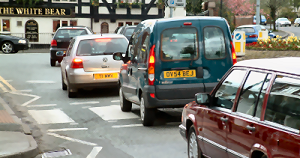
A final note about arriving at the crossing - If there is a queue of traffic ahead, keep the crossing clear.
The photo shows a van driver who has stopped on the crossing - this is dangerous and illegal because it obstructs the pedestrian's view and makes it difficult for drivers to see pedestrians
It is illegal for any vehicle to block a crossing except where necessary to avoid injury or damage. You must never block a pedestrian crossing of any type - treat it as a footpath.
It is also a good idea to leave a gap of one or two car lengths clear beyond the crossing. This will help drivers from the opposite direction to see the crossing more clearly.
It might be worth mentioning here that apart from being dangerous, if you break the rules at pedestrian crossings you could face a fine of up to £1,000 (worst offences), get three penalty points (quite common) or even be disqualified from driving.
In addition to no overtaking, the zig-zag lines at crossings also mean NO PARKING. Not to pick up a friend, not to pop into a shop, not to get a takeaway or for any other reason.
The no-parking rule is in place for the same reason as the no-overtaking rule - a parked vehicle would obstruct the view of drivers and pedestrians.
Look at the photo.
Can you see the pedestrians waiting to cross from behind the red van on the left-hand side? The answer is a big fat "No" (unless you have X-Ray vision!).
If you were driving along this road, the pedestrians would not be able to see you either!
All it would take for disaster is a pedestrian who is in a hurry to cross and a driver who is not responding to the potential danger.
This example of parking on zig-zag lines is an extreme case of dangerous parking; the driver would face a serious charge if an accident happened. This is not a simple parking offence. If you park on zig-zag lines at a crossing, you can expect a fine of around £100 and three points on your driving licence.
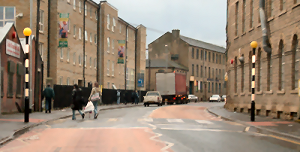
Zebra crossings have flashing amber globe lights, usually mounted on black-and-white poles (the poles can sometimes be grey).
The flashing lights are called 'Belisha Beacons' and are named after Leslie Hore-Belisha - he was the Minister of Transport in 1935 when the driving test was introduced in Great Britain.
Although the driving test was introduced in 1935, the first Zebra crossing in the UK was not introduced until 1951.
The road surface at a Zebra crossing is marked with black and white stripes and single give-way lines. Some crossings might have anti-skid surfacing on the approach (the red surface shown in the photo).
The zig-zag lines (mentioned earlier) before and after the crossing indicate that you must not park or overtake.
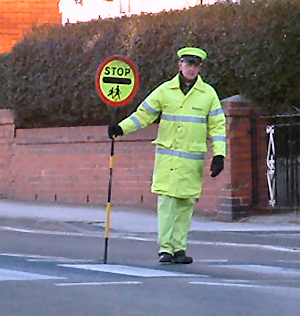 At Zebra crossings, you MUST give way to anyone who has stepped onto the crossing and should give way to anyone who is waiting to cross.
At Zebra crossings, you MUST give way to anyone who has stepped onto the crossing and should give way to anyone who is waiting to cross.
Some crossings are split into two halves with an island in the centre of the road; you can treat these as two separate crossings, but be careful - some pedestrians might not know the rules, especially children who could run from one side to the other.
Sometimes the crossings are controlled by school crossing wardens. If this is the case, you must obey the instructions of the warden - but always check for yourself to make sure that the crossing is clear before moving off.

Pelican crossings are being phased out and replaced with Puffin Crossings - but there are still some Pelican Crossings around, and it might be some years until they are all replaced.
Pelican crossings have traffic lights, but the sequence of the lights is slightly different from standard traffic lights.
The main difference is the 'flashing amber' light; it's easy to remember what this is for because it means precisely the same thing as the Belisha Beacon at Zebra crossings - give way to pedestrians.
The image on the right shows the old-style pedestrian buttons still fitted at many Pelican Crossings.
Use your hazard routine approach, looking out for people who might be waiting to cross.
Pedestrians activate the lights by pressing a button when they want to cross. If the lights are green, but you see pedestrians waiting, there is a good chance that you will have to stop (when the lights change) - slow down early and be prepared for the lights to change.
Because the lights are triggered solely by pedestrians pressing the button, the lights can change when no one is there. For example, children might press the button and then run away! You can get a clue by looking at the box where the pedestrian button is located (see picture above) - if the 'wait' sign is lit, the lights will soon change.
Important: Unlike Zebra crossings, when a Pelican crossing goes straight across the road but is split by an island in the middle, it is treated as a single crossing.
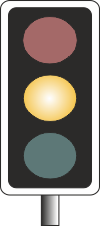
Steady amber
STOP and give way to pedestrians. You may only proceed at a steady amber traffic light if you have crossed the stop line or are so close to it that stopping might cause an accident.
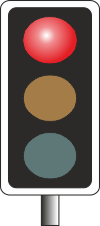
Red
STOP behind the stop line and give way to pedestrians.
Your approach speed must always be slow enough to stop at red.
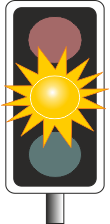
Flashing amber
Give way to pedestrians, who are crossing.
If the crossing and the road beyond the crossing are clear, you can proceed (if it is safe to do so).
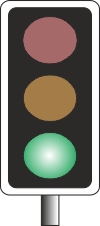
Green
Proceed if the crossing is clear and it is safe to do so and the road beyond the crossing is clear.
If pedestrians are still crossing, or walk out in front of you, you must stop and wait.
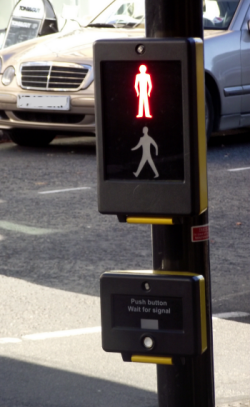
As mentioned earlier, Puffin crossings are replacing Pelican crossings. The name incorporates the letters PUF - Pedestrian User Friendly.
These crossings differ from pelican crossings from a driver's point of view because they do not have a 'flashing amber' phase. The lights follow the same sequence as standard traffic lights.
At Puffin crossings, the red man/green man lights are mounted above the push button unit and not on the opposite side of the road.
When pedestrians look at the lights, they also have the oncoming traffic in their line of sight. This arrangement also makes it easier for partially sighted people to see the red/green man.
Puffin crossings are also 'intelligent'. They monitor the traffic and pedestrians to ensure the lights change at an appropriate time.
By monitoring the pedestrian movement on the crossing, the lights can vary the length of the red phase - this means if someone is a bit slow crossing the road (for example, an older person), the lights stay red for longer.
Some crossings also monitor the footpath so that if a pedestrian presses the button and then walks away, the lights won't change needlessly.

Green
Proceed if the crossing is clear and it is safe to do so and the road beyond the crossing is clear.
If pedestrians are still crossing, or walk out in front of you, you must stop and wait.

Steady amber
STOP and give way to pedestrians. You may only proceed at a steady amber traffic light if you have crossed the stop line or are so close to it that stopping might cause an accident.

Red
STOP behind the stop line and give way to pedestrians.
Your approach speed must always be slow enough to stop at red.
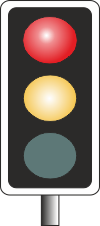
Red & Amber
STOP behind the stop line and give way to pedestrians.
Get ready to go, but wait for green before starting to move.
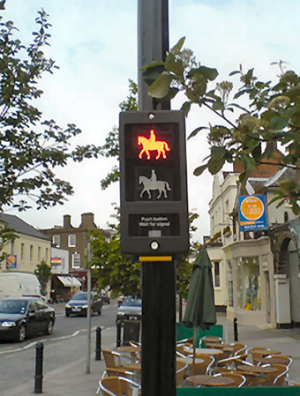 From a technical point of view, Toucan and Equestrian crossings work the same way as Puffin crossings. They sense the presence of people waiting to cross and monitor the traffic. The difference is that these crossings are for pedestrians, horses (Equestrian), and cyclists (Toucan).
From a technical point of view, Toucan and Equestrian crossings work the same way as Puffin crossings. They sense the presence of people waiting to cross and monitor the traffic. The difference is that these crossings are for pedestrians, horses (Equestrian), and cyclists (Toucan).
The most obvious difference at an Equestrian crossing is that the 'pedestrian' button is mounted higher up so that horse riders can reach it without dismounting.
Be cautious when there are horses around. Remember that animals are unpredictable and could easily take you by surprise.
Sometimes it might be worthwhile stopping a car length behind the stop line when the lights are red - maybe even switching off your engine if a horse appears to be 'skittish'.
'Toucan' follows the theme of naming crossings after birds - this time, the choice is a bit corny.
The meaning is 'Two Can' - two can cross together (pedestrian and cyclist).
At Toucan crossings, there are often separate 'lanes' for cyclists and pedestrians to cross the road.
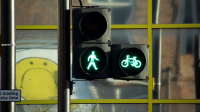 From a driver's point of view, there is no difference in approach.
From a driver's point of view, there is no difference in approach.
However, you need to be especially careful when moving off because 'last second' cyclists might be travelling quite fast to 'beat the lights'.
Combined is the DriverActive name for pedestrian crossings combined with regular junction traffic lights.
Pedestrians don't always take notice of the traffic signals and might not expect you to appear from around a corner. At busy, light-controlled junctions, you will primarily be concentrating on traffic. Because of this, it's essential to scan the footpath for pedestrians and cyclists, especially when turning left or right.
Another point here is that pedestrians might not always cross where you expect them to - they might cross the junction diagonally (across the middle of the junction) rather than cross one road at a time.
 Sometimes these crossings are linked with turning restrictions. For example - at a junction controlled with a 'no right turn' sign, the pedestrian light on the road to the right may be green at the same time as the traffic light on the main road. This is why it is essential that you always obey signs - even if you don't know why they have been put in place.
Sometimes these crossings are linked with turning restrictions. For example - at a junction controlled with a 'no right turn' sign, the pedestrian light on the road to the right may be green at the same time as the traffic light on the main road. This is why it is essential that you always obey signs - even if you don't know why they have been put in place.

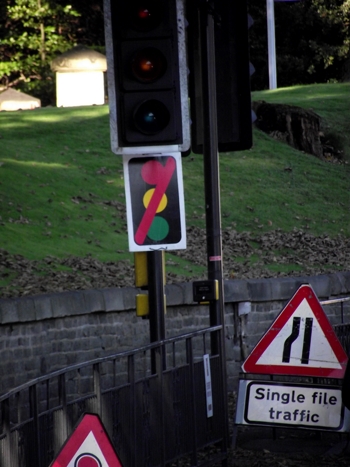 The rules for Pelican and other traffic light-controlled crossings change when the traffic lights are out of order.
The rules for Pelican and other traffic light-controlled crossings change when the traffic lights are out of order.
When this happens, pedestrians will often face a 'crossing out of use' sign - but they still want to cross the road!
Sometimes there will be a sign informing you that the lights are not working, but this will not always be the case - the lights might only have failed a few minutes before you arrive.
When the lights are out, you need to take the utmost care - our advice is that you should treat the crossing like a Zebra Crossing and be prepared to give way - but you must be aware that other drivers might not recognise the situation or what you are doing to deal with it.
Always consider whether any drivers are approaching from the opposite direction - take care not to 'tempt' pedestrians to step out in front of a moving vehicle and never instruct pedestrians to cross.
Lights are rarely out of order but if you come across this situation, check your mirrors and the road ahead and then make a decision based on what is happening at the time - this could be different every time.
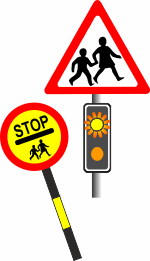
We mentioned earlier that a school crossing warden might control Zebra crossings. Wardens can also be on duty at other crossing types, and the same rule applies.
Not all school wardens operate at fixed pedestrian crossings - often, they operate on the open road near schools.
Wherever you see a school warden, you must obey the instructions they give you.
Always take extra care around schools, especially when the flashing amber lights are showing under a school warning sign. Children might not be paying attention to traffic and could run into the road at any time - expect it to happen!
Stop when signalled to do so by the warden and only proceed when the warden instructs you to do so. Failing to stop can result in a fine of up to £1000 in extreme cases. It will also get you 3 points on your licence.
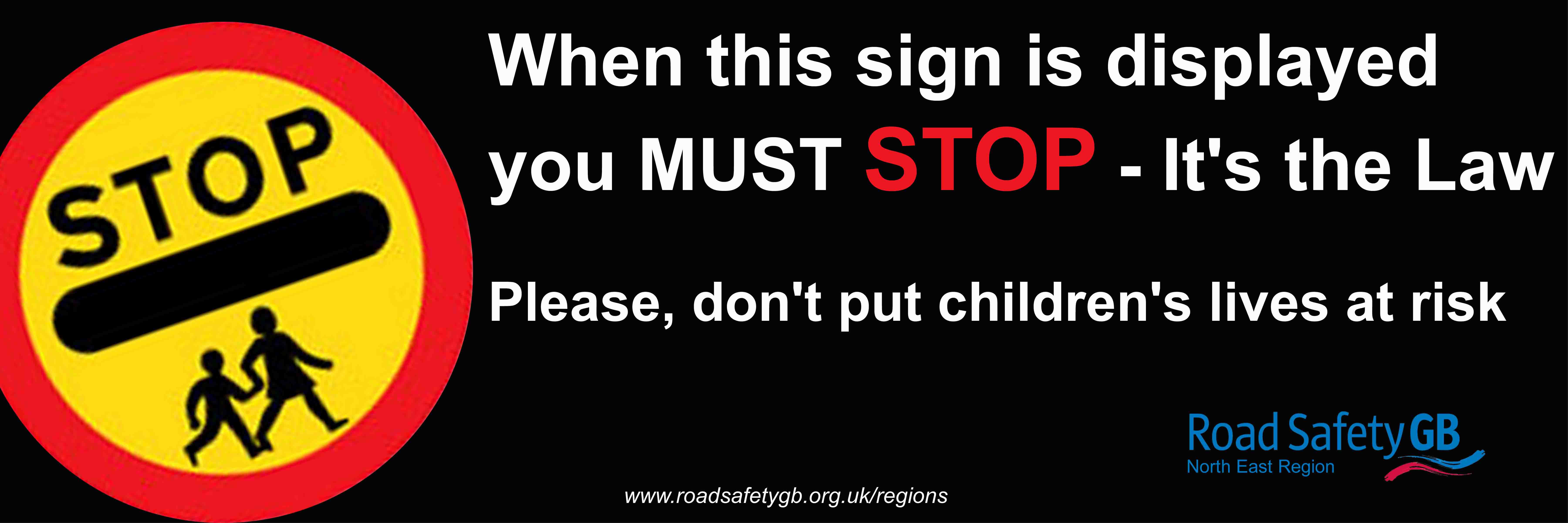

No,it's not a misprint.
There are tiger crossings in the UK. And they are not near zoos!
Tiger crossings are a variation of the UK Zebra crossing originating in Hong Kong. The crossings are painted yellow and black - hence the name.
They are rare in the UK, but you might come across them in London and Bournemouth. Other areas might also install the crossings, so be on the lookout.
The crossings are effectively Zebra crossings with an added lane for cyclists. They allow cyclists to cross the road without dismounting. Drivers have to give way to cyclists and pedestrians.
The cycle crossing is parallel to the zebra crossing. The photo shows a crossing that runs across the road at an angle - but it's more common for them to run straight across at a 90-degree angle to the footpath.
Tiger crossings are not currently shown in the Highway Code, and you are unlikely to be asked about them in the driving theory test.
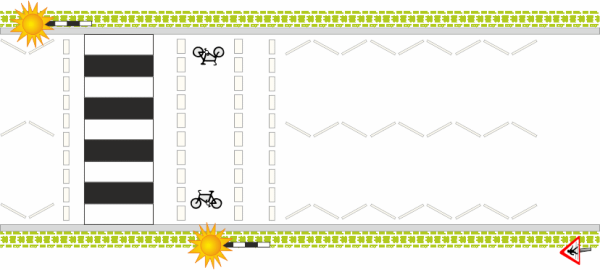
 Pedestrian Safety Quiz...
Pedestrian Safety Quiz...Click here to complete the quiz for this lesson
(The page will open in a new window/tab)
You will find references for the answers in this lesson.
You can check your answers as you go along, or complete the full quiz before checking.
Leaving the check to the end is a good way to test yourself.
When you check or review your answers you will get a brief explanation of the answer.
Good Luck!